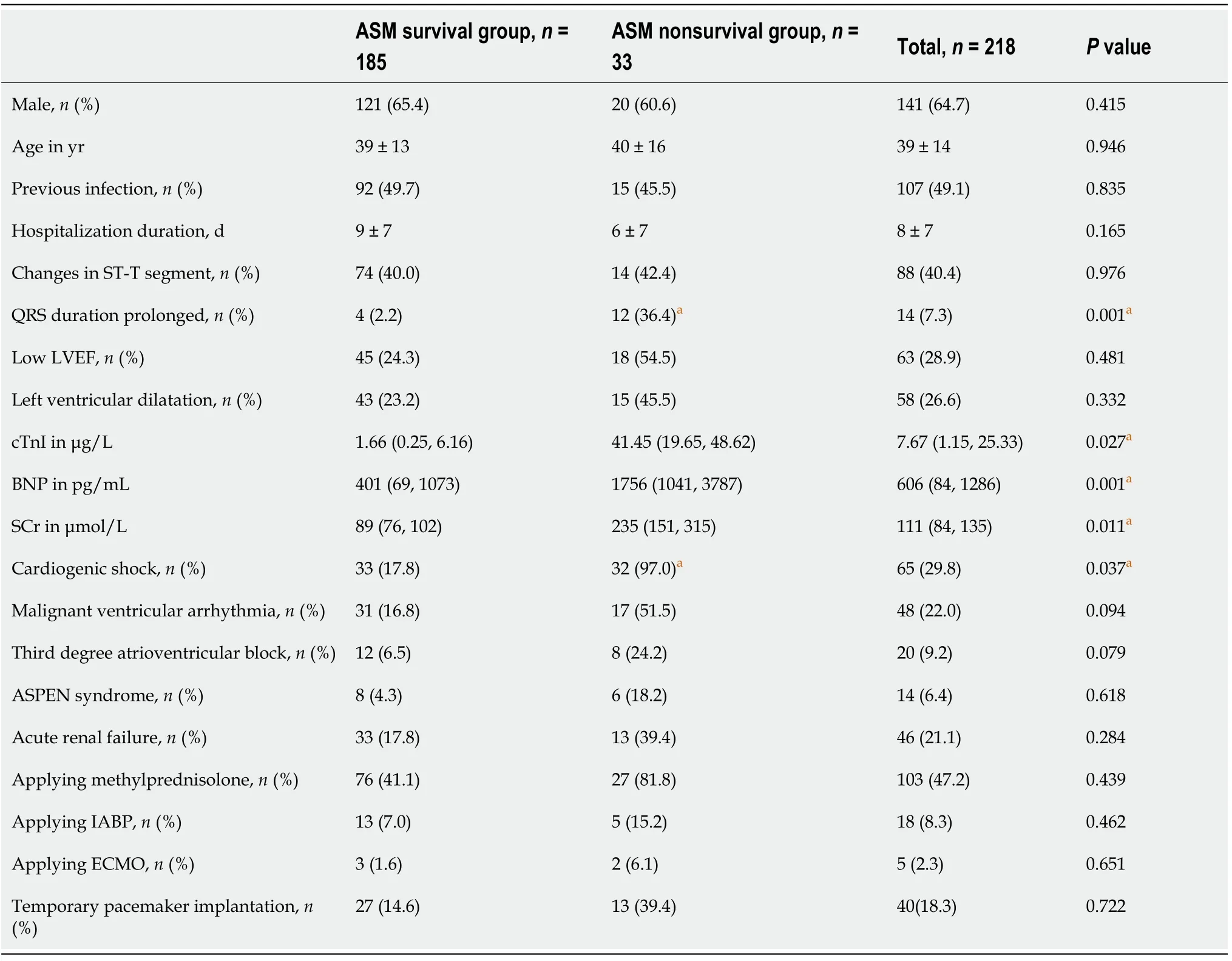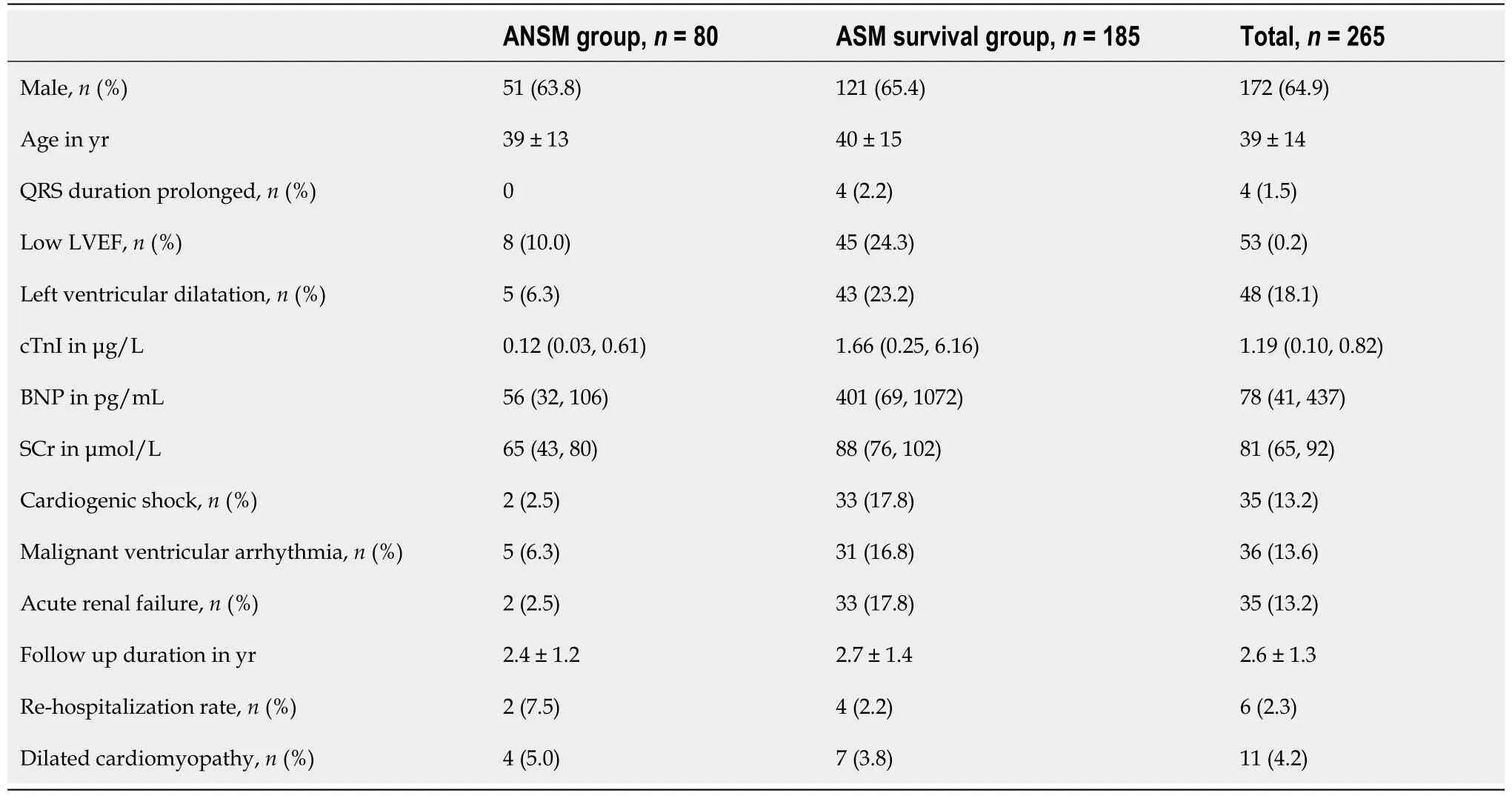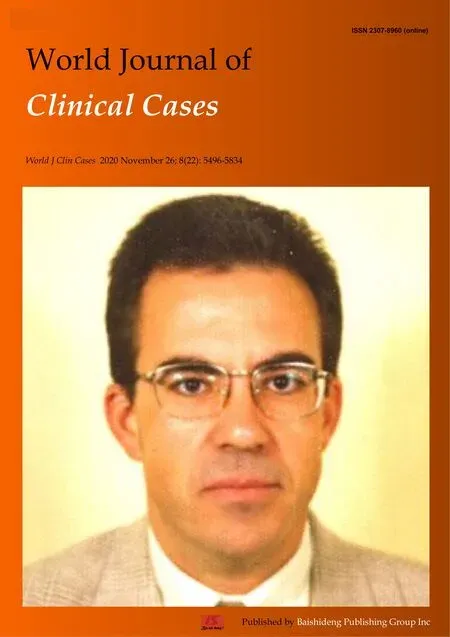Risk factors analysis of prognosis of adult acute severe myocarditis
Qian Zhang,Rui Zhao,Department of Heart Center,Peking University People's Hospital,Beijing 100044,China
Abstract BACKGROUND Adult severe myocarditis is primarily caused by infection with any number of a variety of viruses. It arises quickly,progresses rapidly,and may lead to severe heart failure or circulatory failure presenting as rapid-onset hypotension and cardiogenic shock with a high hospital mortality rate.AIM To analyze the risk factors affecting the short-term prognosis of adult acute severe myocarditis (ASM).METHODS Adult patients with ASM (ASM group,n = 218) and acute nonsevere myocarditis(ANSM group,n = 80) who came to our department from January 2014 to January 2020 were enrolled in this study. Patients with ASM were divided into the ASM survival group (n = 185) and ASM nonsurvival group (n = 33) according to the treatment results during hospitalization. The clinical symptoms,laboratory examinations,treatment methods,complications,and the relationship between the treatment results of the two groups were retrospectively compared and discussed. The risk factors for death in patients with severe myocarditis were analyzed by binary logistic regression. A follow-up to 5.5 years was conducted on patients in the ASM survival group and ANSM group after discharge,and the readmission rate and incidence rate of dilated cardiomyopathy were analyzed.RESULTS Compared with the ASM survival group,the ASM nonsurvival group had longer QRS complex,higher incidence of cardiogenic shock,higher serum creatinine(SCr,235μmol/L vs 89 μmol/L,P < 0.05),higher sensitive cardiac troponin I (cTnI,4.45 μg/L vs 1.66 μg/L,P < 0.05) and brain natriuretic peptide (BNP,1756 pg/mL vs 401 pg/mL,P < 0.05). The binary logistic regression revealed that there were statistical differences between the two groups in SCr,cTnI,and BNP values (all P< 0.05). After discharging from the hospital,patients in the ASM group and ANSM group had no significant differences in the readmission rate and incidence rate of dilated cardiomyopathy.CONCLUSION Elevated SCr,cTnI,and BNP are independent predictors for poor prognosis in patients with ASM. The long-term prognosis of patients in the ASM survival group is good.
Key Words: Acute severe myocarditis; Risk factor; Hospital mortality; Prognosis; Dilated cardiomyopathy
INTRODUCTION
According to the World Health Organization’s classification of cardiomyopathies,myocarditis is clinically and pathologically defined as an inflammatory disease of the myocardium diagnosed by established histological,immunological,and immunohistochemical criteria. The actual incidence of myocarditis is difficult to determine as endomyocardial biopsy (EMB),the diagnostic gold standard,is used infrequently[1]. Studies addressing the issue of sudden cardiac death in young people reported a highly variable autopsy rate ranging from 2% to 42% of cases[2]. Similarly,biopsy-proven myocarditis is reported in 9% to 16% of adult patients with unexplained nonischemic dilated cardiomyopathy (DCM) and 46% of children with identified causes of DCM[3]. Besides,biopsy-proven myocarditis can progress to DCM and is associated with a poor prognosis in up to 30% of cases[4].
In patients presenting mild symptoms and minimal ventricular dysfunction,myocarditis often resolves spontaneously without specific treatment[2]. Nevertheless,in patients with acute severe myocarditis (ASM),which has the characteristics of acute onset,severe illness,and high mortality rate,cardiovascular adverse events such as heart failure,malignant arrhythmia,cardiac arrest,and even sudden death may easily occur. Early identification of patients with a severe tendency is of great significance for selecting treatment strategies and improving the prognosis. This study retrospectively analyzed the data of patients with endocarditis admitted to our department from January 2014 to January 2020. Through the comparison between ASM survival patients and ASM nonsurvival patients and ASM survival patients and acute nonsevere myocarditis (ANSM) patients,we discussed the risk factors for in-hospital death and prognosis in patients with ASM.
MATERIALS AND METHODS
Study population
ASM patients and ANSM patients admitted to our department from January 2014 to January 2020 were enrolled in this study. Inclusion criteria for adult patients with ASM were:(1) Age > 18-years-old; and (2) In accordance with the diagnostic criteria for acute viral myocarditis and accompanied by at least one of the obvious cardiac enlargement,congestive heart failure,cardiogenic shock,severe arrhythmia,increased troponin,galloping horse,or pericardial friction sound,which is consistent with the diagnosis of ASM[5]. Inclusion criteria for patients with ANSM were:(1) 18-75-yearsold; and (2) In accordance with the diagnostic criteria of acute viral myocarditis.Exclusion criteria were:(1) < 18- or > 75-years-old; and (2) Complicated by the following diseases:Acute coronary syndrome,chronic cardiac insufficiency NYHA Class III-IV,chronic renal insufficiency class III-V,and stroke. Patients with ASM were divided into the ASM survival group and ASM nonsurvival group according to the treatment results during hospitalization. Patients in the ASM survival group and patients in the ANSM group (control group) were followed up for 0.4-5.5 years.
Methods
This is a retrospective cohort study. The basic characteristics,electrocardiogram (ECG)characteristics,laboratory examinations (taking the peak value of abnormal values),treatment methods,in-hospital complications,length of stay,and other clinical data were recorded. The primary endpoint of this study was in-hospital death. The changes of ST-T segment of ECG (suggesting myocardial ischemia),prolongation of QRS duration (suggesting bundle branch block),left ventricular ejection fraction,left ventricular inner diameter,high-sensitivity cardiac troponin I (cTnI,normal value <3.1 ng/mL),brain natriuretic peptide (BNP,normal value < 100 pg/mL),serum creatinine (SCr,normal value < 100 pg/mL),and major complications (cardiogenic shock,malignant arrhythmia,third-degree atrioventricular block,aspen syndrome,acute renal failure,etc.) were also recorded. Patients were followed up for 0.4-5.5 years after discharge,and the recovery,readmission,and dilated cardiomyopathy were recorded and compared.
Statistical analysis
The data were analyzed by SPSS 25.0 statistical software (SPSS,Inc.,Chicago,IL,United States). Continuous variables were presented as mean ± standard deviations and were compared using Studentttest as appropriate. Non-normal distribution data were expressed by M (Q1,Q3),and Mann-WhitneyUtest was used. The comparison between groups was performed byχ2test or Fisher’s exact test. The logistic stepwise regression analysis was used to analyze the risk factors for the prognosis of ASM patients. Statistical significance was set at aPvalue < 0.05.
RESULTS
A total of 265 patients were enrolled in our study,including 185 ASM and 80 ANSM patients. Of all the patients,64.9% of patients (n= 172) were male with an average age of 39 ± 14-years-old (Table 3). A total of 33 ASM patients (male,n= 20) died in the hospital,with an average age of 40 ± 16-years-old (Table 1).
Risk factors of death in adult patients with ASM
Single risk factor analysis:Compared with the ASM survival group,the duration of QRS complex,levels of cTnI,BNP,and SCr,and the incidence of the cardiogenic shock of patients in the ASM nonsurvival group were significantly increased (allP< 0.01).There was no statistical difference in basic characteristics,ST-T segment change of electrocardiogram,low left ventricular ejection fraction (LVEF),left ventricular enlargement,the incidence rate of major complications,and hospitalization length between the two groups (Table 1).
Multivariate regression analysis:Binary logistic regression analysis revealed that the levels of SCr,cTnI,and BNP in the two groups were statistically different,which indicated that the abnormal increases of these three indicators were independent predictors for poor prognosis of patients with ASM (Table 2).
Follow-up
There was no statistical difference in the follow-up duration between different groups.Two patients in the ASM survival group were readmitted to our department for treatment due to chest tightness and fatigue. They were diagnosed with DCM and improved after conservative treatment; one patient was readmitted for pacemaker implantation due to intermittent second-degree type II atrioventricular block within 1 year after discharge. One patient in the ANSM group was readmitted to our department due to chest tightness,palpitation,and increased cTnI. ANSM was diagnosed again,and the patient was discharged smoothly after conservative treatment; another patient was readmitted 4 years after discharge due to chest tightness,fatigue,and increased BNP and was diagnosed with dilated cardiomyopathy. There was no statistical difference between the readmission rate and the incidence rate of DCM between the two groups (Table 3).

Table 1 Analysis of risk factors for death of acute severe myocarditis patients

Table 2 Binary logisti c regression analysis on risk factors of acute severe myocarditis patients’ deaths
DISCUSSION
Previous studies have shown that in patients presenting with mild symptoms and minimal ventricular dysfunction,myocarditis often resolves spontaneously without specific treatment,but there were also some patients whose condition deteriorated rapidly. Cardiogenic shock,malignant ventricular arrhythmia,cardiac arrest,and even death often occurred within a few days after diagnosis[1,2]. Myocarditis patients can have partial or full clinical recovery; some may relapse many years after the first episode. Relapses should be managed similarly to the index episode. For those who do not resolve,the disease may continue subclinically and lead to DCM[6]. At present,there is still a lack of reliable clinical indicators to predict the prognosis of ASM patients.

Table 3 Comparison between acute nonsevere myocarditis group and acute severe myocarditis survival group
A study revealed that indicators for poor prognosis included hypotension (blood pressure < 85/50 mmHg),high pulmonary capillary osmotic pressure,and application of mechanical ventilation,while sex,age,heart rate,cardiac output,creatine kinase peak value,and whether an intra-aortic balloon pump (IABP) was applied or not had no obvious influence on mortality[7]. Another study pointed out that patients with increased left ventricular diameter,decreased left ventricular systolic function,and gadolinium delayed enhancement in cardiac magnetic resonance (CMR) imaging have poor prognosis[8]. Studies concerned with the diagnosis of viral myocarditis by endometrial biopsy,immunohistochemistry,and polymerase chain reaction revealed that a cardiac function of NYHA Class III-IV and positive immunohistochemistry usually indicated a poor prognosis[9]. Recent studies have pointed out that systolic depression,left ventricular enlargement and low LVEF accompanied by acute renal failure and prolonged QRS complex were independent risk factors for poor prognosis of ASM patients[10-13].
Myocardial biopsy is of high value in predicting the early and long-term prognosis of myocarditis. We recommended that all patients with suspected myocarditis should undergo an EMB which is not a routine practice. Studies revealed that the prognosis of ASM with lymphocytic infiltration was worse than that with eosinophilic infiltration.There were statistically significant differences in all-cause mortality (37.5%vs0%,P<0.05) and cardiac mortality (31.2%vs0%,P< 0.05)[3]. However,an invasive myocardial biopsy is still limited in clinical practice. Noninvasive imaging techniques such as CMR imaging can be useful in making the diagnosis of myocarditis and for monitoring disease progression,but we strongly endorse the concept that EMB should be the gold standard for the diagnosis of definite myocarditis[15,16].
This study found that patients in the ASM nonsurvival group and ASM survival group had significant differences in the intraventricular block (prolongation of QRS duration),SCr,cTnI,BNP value,cardiogenic shock,etc.However,there were no significant differences in sex,preinfection,ST-T segment change of the electrocardiogram,left ventricular enlargement,LVEF value,malignant arrhythmia,acute renal failure,incidence rate of antisynthetase syndrome,etc.Binary logistic regression analysis revealed that the elevated SCr,cTnI,and BNP values can be used as independent predictors of poor prognosis. The level of cTnI could reflect the degree of myocardial damage,and the increase of SCr value was a sensitive indicator for renal insufficiency. Cardiac insufficiency can cause hemodynamic abnormalities and promote the occurrence and development of renal insufficiency,which in turn can lead to water and sodium storage,electrolyte disturbance,acid-base imbalance,increased cardiac load,destroyed internal environment in which myocardial cells normally work,and formation of a vicious circle of cardiac and renal insufficiency. The occurrence of the above complications often indicates the aggravation of ASM.
Another important finding of our research was that the appearance of aberrant occurrence conduct when patients had just been admitted to the hospital was closely related to the clinical death of patients. Of the 33 patients who died in this study,a total of eight patients developed a ventricular block,and all patients died of malignant ventricular arrhythmia and cardiac arrest eventually. We believed this could be caused by myocardial congestion,edema,and extensive myocardial injury,which reflected the severity of the disease. We recommend that temporary pacemakers,extracorporeal membrane oxygenation (ECMO),and IABP should be applied in time when aberrant ventricular conduction occurs.
At present,there is no effective treatment for ASM. The major therapeutic strategies are myocardial nutrition,maintenance of water and electrolyte balance,conservative drug therapy,and immunosuppressive treatment. Furthermore,whether immunosuppressive therapy can effectively improve the prognosis of ASM patients is still controversial. Myocardial biopsy results confirmed that immunotherapy was effective in patients with eosinophilic myocarditis and giant cell myocarditis[17,18]but has no obvious effect on suspected or definite viral or lymphocytic myocarditis[19]. All ASM patients enrolled in this study were treated with a large dose of glucocorticoid(methylprednisolone 400-1000 mg/d). After 3 d of treatment,they were changed to oral prednisone and gradually reduced to discontinuation. In our study,due to the lack of comparison with the control group,it was difficult to make an objective and accurate evaluation on the curative effect of the hormone. However,we found that most patients’ symptoms were noticeably relieved after hormone application,and no obvious adverse reactions occurred. There is controversy about whether the application of immunoglobulin can effectively improve the prognosis of ASM patients at present[12,20],so we did not use immunoglobulin for patients.
For ASM patients with severe hemodynamic disorder,cardiogenic shock,and pulmonary failure,the timely use of ECMO,IABP and other life-support equipment will help to eliminate the cardiopulmonary function. This will reduce the burden on the heart and lungs and help the patients to pass through the critical stage,which has significant curative effects on improving the prognosis and reducing mortality[21]. In this study,a total of five patients received ECMO implantation,in which two patients(40%) died eventually. This indicated that ECMO application had no significant difference in improving prognosis,which might be related to factors such as a small sample size included in this study and bias.
Furthermore,we must realize that ASM is a self-limited disease. Patients in the severe stage can gradually enter the recovery period after 7-10 d of onset. However,the intermittent atrioventricular block,ventricular arrhythmia,left ventricular enlargement,LVEF reduction,and other conditions may be left after discharge from the hospital. Very few patients will develop DCM. The average follow-up time of patients in this study was 2 years. During this period,four patients in the ASM group and two patients in the ANSM group developed DCM. Due to the small sample size and short duration of follow-up in this study,the reason why ASM developed into DCM was still unclear. In the future,multicenter,large sample size,randomized controlled trials will be needed to explore the predictive value of various laboratory indicators on the prognosis of ASM.
CONCLUSION
Increased SCr,cTnI,and BNP value are independent risk factors for poor prognosis of ASM patients. Patients with an intraventricular block (prolonged QRS wave of electrocardiogram) have a higher mortality rate. The prognosis of ASM patients is generally good. Clinicians can classify patients with myocarditis according to their SCr,cTnI,and BNP value when they are admitted to the hospital to make clear the severity of their illness.
ARTICLE HIGHLIGHTS
Research background
Adult acute severe myocarditis (ASM) is acute in onset and severe in condition with different clinical manifestations and prognosis. After regular treatment,most patients with ASM had a good prognosis,but a few patients died of cardiogenic shock and malignant arrhythmia. Some patients developed dilated cardiomyopathy,third-degree atrioventricular block,and chronic arrhythmia after discharge.
Research motivation
A way to effectively assist clinicians in grading the severity of myocarditis patients when they are admitted to the hospital is urgently needed.
Research objectives
This retrospective study aimed to find the related factors influencing the early prognosis and analyze the results of follow-up in adult patients with acute fulminant myocarditis.
Research methods
Adult patients with acute myocarditis who came to our department from January 2014 to January 2020 were enrolled in this study. They were divided into two groups according to the degree of illness. The clinical symptoms,laboratory examination,treatment methods,complications,and the relationship between the treatment results of the two groups were retrospectively compared and discussed. The risk factors for death in patients with severe myocarditis were analyzed by binary logistic regression.A follow-up to 5.5 years was conducted on patients in the ASM survival group and acute nonsevere myocarditis group after discharge,and the readmission rate and incidence rate of dilated cardiomyopathy were analyzed.
Research results
A total of 265 patients,including 185 ASM and 80 acute nonsevere myocarditis patients were enrolled in our study. Of all the patients,64.9% of patients (n= 172) were male with an average age of 39 ± 14-years-old. A total of 33 ASM patients (male,n=20) died in the hospital with an average age of 40 ± 16-years-old. Compared with those in the survival group,the incidence of QRS wave duration,cardiac shock,serum creatinine (SCr) level,cardiac troponin I (cTnI) level,and brain natriuretic peptide(BNP) level significantly increased in the nonsurvival group. Furthermore,binary logistic regression analysis suggested that SCr,cTnI,and BNP levels were independently correlated with the prognosis in patients with fulminant myocarditis.No significant difference was found in the rehospitalization rate and the morbidity of dilated cardiomyopathy between the survival group and the nonsurvival group. In addition,adult patients with acute fulminant myocarditis discharged from the hospital have a good long-term prognosis.
Research conclusions
Increased SCr,cTnI,and BNP values are independent risk factors for poor prognosis of ASM patients. Clinicians can classify patients with myocarditis according to their SCr,cTnI,and BNP values when they are admitted to the hospital to make clear the severity of illness.
Research perspectives
So far,ASM developing to dilated cardiomyopathy is still unclear. Multicenter,large sample size,randomized controlled trials will be needed to explore the predictive value of various laboratory indicators on the prognosis of ASM.
 World Journal of Clinical Cases2020年22期
World Journal of Clinical Cases2020年22期
- World Journal of Clinical Cases的其它文章
- COVID-19:A review of what radiologists need to know
- Holistic care model of time-sharing management for severe and critical COVID-19 patients
- Bioequivalence of two esomeprazole magnesium enteric-coated formulations in healthy Chinese subjects
- Osteoprotegerin,interleukin and hepatocyte growth factor for prediction of diabetes and hypertension in the third trimester of pregnancy
- High serum lactate dehydrogenase and dyspnea:Positive predictors of adverse outcome in critical COVID-19 patients in Yichang
- Sonographic features of umbilical vein recanalization for a Rex shunt on cavernous transformation of portal vein in children
